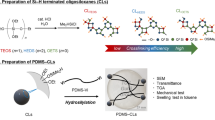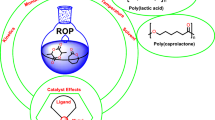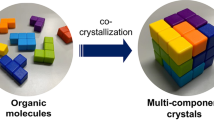Abstract
The synthesis of a monomer containing fourfold hydrogen bonding groups 2-(((6-(6-methyl-4[1H]pyrimidionylureido)hexyl)carbamoyl)oxy)ethyl methacrylate (UPyEMA) and its copolymerization with either n-butyl acrylate, tert-butyl acrylate, or styrene using reversible addition-fragmentation chain transfer (RAFT) polymerization is reported. The copolymers possessed high molecular weight and narrow molecular weight distributions and formed stable organogels in both chloroform and 1,2-dichlorobezene. Critical gelation concentrations were determined and the rheology of the organogels characterized. A novel monomer containing pyrene was prepared, and its polymerization under RAFT control was demonstrated. The pyrene-containing monomer was copolymerized with the polymer organogelators forming fluorescent organogels. It is proposed that these gels are suitable for two-photon upconversion applications.









Similar content being viewed by others
References
Sahoo S, Kumar N, Bhattacharya C, Sagiri S, Jain K, Pal K, Ray S, Nayak B (2011) Organogels: properties and applications in drug delivery. Des Monomers Polym 14:95–108
Ajayaghosh A, Praveen VK, Vijayakumar C (2008) Organogels as scaffolds for excitation energy transfer and light harvesting. Chem Soc Rev 37:109–122
Puigmartí‐Luis J, Laukhin V, Pérez del Pino Á, Vidal‐Gancedo J, Rovira C, Laukhina E, Amabilino DB (2007) Supramolecular conducting nanowires from organogels. Angew Chem Int Ed 46:238–241
Sijbesma RP, Beijer FH, Brunsveld L, Folmer BJ, Hirschberg JK, Lange RF, Lowe JK, Meijer E (1997) Reversible polymers formed from self-complementary monomers using quadruple hydrogen bonding. Science 278:1601–1604
Li G, McGown LB (1994) Molecular nanotube aggregates of β-and γ-cyclodextrins linked by diphenylhexatrienes. Science 264:249–251
Van Nostrum CF, Nolte RJ (1996) Functional supramolecular materials: self-assembly of phthalocyanines and porphyrazines. Chem Commun 1996:2385–2392
Michelsen U, Hunter CA (2000) Self-assembled porphyrin polymers. Angew Chem Int Ed 39:764–767
Liu Z-X, Feng Y, Yan Z-C, He Y-M, Liu C-Y, Fan Q-H (2012) Multistimuli responsive dendritic organogels based on azobenzene-containing poly(aryl ether) dendron. Chem Mater 24:3751–3757
Liu Q, Wang Y, Li W, Wu L (2007) Structural characterization and chemical response of a Ag-coordinated supramolecular gel. Langmuir 23:8217–8223
Thibault RJ, Hotchkiss PJ, Gray M, Rotello VM (2003) Thermally reversible formation of microspheres through non-covalent polymer cross-linking. J Am Chem Soc 125:11249–11252
Girolamo M, Keller A, Miyasaka K, Overbergh N (1976) Gelation‐crystallization in isotactic polystyrene solutions and its implications to crystal morphology, to the origin and structure of gels, and to the chemical homogeneity of polyolefins. J Polym Sci B Polym Phys 14:39–61
Saiani A, Guenet JM (1997) On the helical form in syndiotactic poly(methyl methacrylate) thermoreversible gels as revealed by small-angle neutron scattering. Macromolecules 30:966–972
Kim KT, Park C, Vandermeulen GW, Rider DA, Kim C, Winnik MA, Manners I (2005) Gelation of helical polypeptide–random coil diblock copolymers by a nanoribbon mechanism. Angew Chem 117:8178–8182
Tadmor R, Khalfin RL, Cohen Y (2002) Reversible gelation in isotropic solutions of the helical polypeptide poly (γ-benzyl-l-glutamate): kinetics and formation mechanism of the fibrillar network. Langmuir 18:7146–7150
Hentschel J, Börner HG (2006) Peptide-directed microstructure formation of polymers in organic media. J Am Chem Soc 128:14142–14149
Naik SS, Savin DA (2009) Poly (Z-lysine)-based organogels: effect of interfacial frustration on gel strength. Macromolecules 42:7114–7121
Carretti E, Dei L, Baglioni P, Weiss RG (2003) Synthesis and characterization of gels from polyallylamine and carbon dioxide as gellant. J Am Chem Soc 125:5121–5129
Suzuki M, Hanabusa K (2010) Polymer organogelators that make supramolecular organogels through physical cross-linking and self-assembly. Chem Soc Rev 39:455–463
Mansfeld U, Winter A, Hager MD, Hoogenboom R, Günther W, Schubert US (2013) Orthogonal self-assembly of stimuli-responsive supramolecular polymers using one-step prepared heterotelechelic building blocks. Polym Chem 4:113–123
Park T, Zimmerman SC, Nakashima S (2005) A highly stable quadruply hydrogen-bonded heterocomplex useful for supramolecular polymer blends. J Am Chem Soc 127:6520–6521
Li J, Lewis CL, Chen DL, Anthamatten M (2011) Dynamic mechanical behavior of photo-cross-linked shape-memory elastomers. Macromolecules 44:5336–5343
Feldman KE, Kade MJ, Meijer E, Hawker CJ, Kramer EJ (2009) Model transient networks from strongly hydrogen-bonded polymers. Macromolecules 42:9072–9081
Cui J, del Campo A (2012) Multivalent H-bonds for self-healing hydrogels. Chem Commun 48:9302–9304
Sijbesma RP, Meijer EW (2003) Quadruple hydrogen bonded systems. Chem Commun 2003:5–16
Folmer BJB, Sijbesma RP, Versteegen RM, van der Rijt JAJ, Meijer EW (2000) Supramolecular polymer materials: chain extension of telechelic polymers using a reactive hydrogen-bonding synthon. Adv Mater 12:874–878
Chen YH, Ballard N, Gayet F, Bon SAF (2012) High internal phase emulsion gels (HIPE-gels) from polymer dispersions reinforced with quadruple hydrogen bond functionality. Chem Commun 48:1117–1119
Lewis CL, Anthamatten M (2013) Synthesis, swelling behavior, and viscoelastic properties of functional poly(hydroxyethyl methacrylate) with ureidopyrimidinone side-groups. Soft Matter 9:4058–4066
Berda EB, Foster EJ, Meijer E (2010) Toward controlling folding in synthetic polymers: fabricating and characterizing supramolecular single-chain nanoparticles. Macromolecules 43:1430–1437
Yamauchi K, Lizotte JR, Long TE (2003) Thermoreversible poly (alkyl acrylates) consisting of self-complementary multiple hydrogen bonding. Macromolecules 36:1083–1088
Brandrup J, Immergut EH, Grulke EA, Abe A, Bloch DR (1999) Polymer handbook, vol 89. Wiley, New York
Chen X, Fei P, Cavicchi KA, Yang W, Ayres N (2014) The poor solubility of ureidopyrimidone can be used to form gels of low molecular weight N-alkyl urea oligomers in organic solvents. Colloid Polym Sci 292:477–484
Wang H, Han A, Cai Y, Xie Y, Zhou H, Long J, Yang Z (2013) Multifunctional biohybrid hydrogels for cell culture and controlled drug release. Chem Commun 49:7448–7450
Yuan J, Fang X, Zhang L, Hong G, Lin Y, Zheng Q, Xu Y, Ruan Y, Weng W, Xia H (2012) Multi-responsive self-healing metallo-supramolecular gels based on “click” ligand. J Mater Chem 22:11515–11522
Duan J, Liang X, Cao Y, Wang S, Zhang L (2015) High strength chitosan hydrogels with biocompatibility via new avenue based on constructing nanofibrous architecture. Macromolecules 48:2706–2714
Aida T, Meijer E, Stupp S (2012) Functional supramolecular polymers. Science 335:813–817
Shih H, Lin C-C (2012) Cross-linking and degradation of step-growth hydrogels formed by thiol–ene photoclick chemistry. Biomacromolecules 13:2003–2012
Wei Z, Yang JH, Zhou J, Xu F, Zrínyi M, Dussault PH, Osada Y, Chen YM (2014) Self-healing gels based on constitutional dynamic chemistry and their potential applications. Chem Soc Rev 43:8114–8131
Rodell CB, Kaminski AL, Burdick JA (2013) Rational design of network properties in guest–host assembled and shear-thinning hyaluronic acid hydrogels. Biomacromolecules 14:4125–4134
Yu X, Cao X, Chen X, Ayres N, Zhang P (2015) Triplet-triplet annihilation upconversion from rationally designed polymeric emitters with tunable inter-chromophore distances. Chem Commun 51:588–591
Islangulov RR, Lott J, Weder C, Castellano FN (2007) Noncoherent low-power upconversion in solid polymer films. J Am Chem Soc 129:12652–12653
Singh-Rachford TN, Lott J, Weder C, Castellano FN (2009) Influence of temperature on low-power upconversion in rubbery polymer blends. J Am Chem Soc 131:12007–12014
Lee SH, Lott JR, Simon YC, Weder C (2013) Melt-processed polymer glasses for low-power upconversion via sensitized triplet-triplet annihilation. J Mater Chem C 1:5142–5148
Baluschev S, Jacob J, Avlasevich YS, Keivanidis PE, Miteva T, Yasuda A, Nelles G, Grimsdale AC, Müllen K, Wegner G (2005) Enhanced operational stability of the up-conversion fluorescence in films of palladium–porphyrin end-capped poly(pentaphenylene). ChemPhysChem 6:1250–1253
Wohnhaas C, Friedemann K, Busko D, Landfester K, Baluschev S, Crespy D, Turshatov A (2013) All organic nanofibers as ultralight versatile support for triplet–triplet annihilation upconversion. ACS Macro Lett 2:446–450
Litvinov VM, Persyn O, Miri V, Lefebvre JM (2010) Morphology, phase composition, and molecular mobility in polyamide films in relation to oxygen permeability. Macromolecules 43:7668–7679
Zhao W, Castellano FN (2006) Upconverted emission from pyrene and di-tert-butylpyrene using Ir (ppy) 3 as triplet sensitizer. J Phys Chem A 110:11440–11445
Acknowledgments
Acknowledgment is made to the donors of the American Chemical Society Petroleum Research Fund (51850-DN17) for support of this research.
Author information
Authors and Affiliations
Corresponding author
Electronic supplementary material
Below is the link to the electronic supplementary material.
ESM 1
(DOCX 1449 kb)
Rights and permissions
About this article
Cite this article
Yu, X., Chen, X., Chai, Q. et al. Synthesis of polymer organogelators using hydrogen bonding as physical cross-links. Colloid Polym Sci 294, 59–68 (2016). https://doi.org/10.1007/s00396-015-3797-z
Received:
Revised:
Accepted:
Published:
Issue Date:
DOI: https://doi.org/10.1007/s00396-015-3797-z




